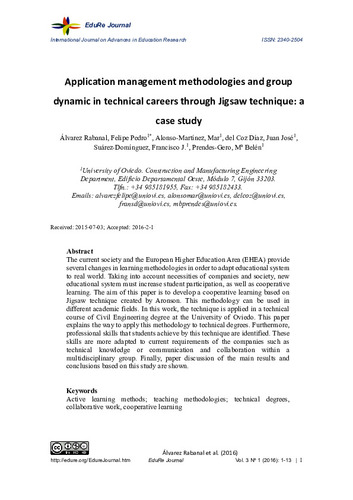Application management methodologies and group dynamic in technical careers through Jigsaw technique: a case study
Subject:
Active learning methods
teaching methodologies
technical degrees
collaborative work
cooperative learning
Publication date:
Editorial:
Pelita International Publishing
Citación:
Abstract:
The current society and the European Higher Education Area (EHEA) provide several changes in learning methodologies in order to adapt educational system to real world. Taking into account necessities of companies and society, new educational system must increase student participation, as well as cooperative learning. The aim of this paper is to develop a cooperative learning based on Jigsaw technique created by Aronson. This methodology can be used in different academic fields. In this work, the technique is applied in a technical course of Civil Engineering degree at the University of Oviedo. This paper explains the way to apply this methodology to technical degrees. Furthermore, professional skills that students achieve by this technique are identified. These skills are more adapted to current requirements of the companies such as technical knowledge or communication and collaboration within a multidisciplinary group. Finally, paper discussion of the main results and conclusions based on this study are shown.
The current society and the European Higher Education Area (EHEA) provide several changes in learning methodologies in order to adapt educational system to real world. Taking into account necessities of companies and society, new educational system must increase student participation, as well as cooperative learning. The aim of this paper is to develop a cooperative learning based on Jigsaw technique created by Aronson. This methodology can be used in different academic fields. In this work, the technique is applied in a technical course of Civil Engineering degree at the University of Oviedo. This paper explains the way to apply this methodology to technical degrees. Furthermore, professional skills that students achieve by this technique are identified. These skills are more adapted to current requirements of the companies such as technical knowledge or communication and collaboration within a multidisciplinary group. Finally, paper discussion of the main results and conclusions based on this study are shown.
ISSN:
Collections
- Artículos [37321]
- Construcción e Ingeniería de Fabricación [504]
Files in this item





